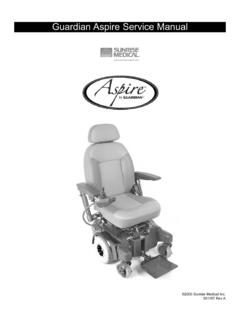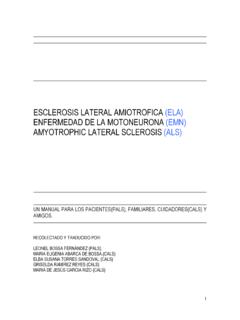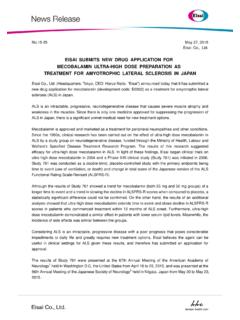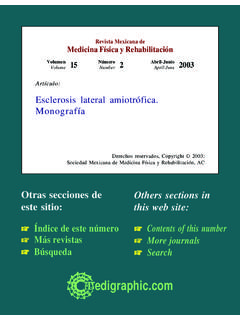Transcription of Mobility Assistive Equipment Group 3 Reference: …
1 Mobility Assistive Equipment Group 3 Reference: ICD-9 Codes *. Funding Guide Common Neurologic Conditions Spinal Cord Injury quadriplegia, Alzheimer's Anterior horn cell disease ..335 quadriplegia, C1 - C4 complete .. Anterior horn cell disease nos .. quadriplegia, C1 - C4 incomplete .. Amyotrophic lateral sclerosis .. quadriplegia, C5 - C7 complete .. CNS demyelination nec .. quadriplegia, C5 - C7 incomplete .. other The provision of Mobility Assistive CNS demyelination nos .. Cerebral Palsy paraplegia nos .. Equipment (MAE) is complex and involves Congenital diplegia .. diplegia of upper extremity .. Spinocerebellar disease ..334 multiple components that must be completed Congenital Congenital quadriplegia.
2 Spinal muscular atrophy .. in order to qualify a patient for coverage and Congenital monoplegia .. Symptomatic torsion dystonia .. Spinocerebellar disease nec .. reimbursement. This guide is intended to assist Infantile hemiplegia .. Cerebral palsy nos .. Spinocerebellar disease nos .. healthcare providers by providing an overview of Cerebellar Ataxia other .. Syringomyelia .. Traumatic Brain Injury quadriplegia .. those components coverage, coding and documentation. Cerebral Lipidosis .. Cerebral degeneration child .. Vascular It is not a substitute for the policy itself and should only Cerebellar degeneration primary .. Werdnig-Hoffman's disease .. be relied upon as a quick-reference guide.
3 Healthcare CIDP (Chronic Inflammatory Demyelinating Polyneuropathy) .. Encephalitis, myelitis, and encephalomyelitis ..323 Myopathy providers should acquaint themselves with the actual policy Friedricks Congenital myopathy .. in order to obtain a thorough understanding of the Medicare Guillian Dermatomyositis (Wagners) .. rules and regulations governing Mobility Assistive Equipment . Hemiplegia / Hemiparesis Myasthenia gravis .. Flaccid hemiplegia unspecified side .. Myotonia congenital .. Medicare's policy for Mobility Assistive Equipment can be Flaccid hemiplegia dominant side .. Myositis Ossificans .. found on the Centers for Medicare & Medicaid Services Flaccid hemiplegia non-dominant side.
4 Muscular Dystrophy Spastic hemiplegia unspecified side .. Beckers .. web site at Spastic hemiplegia dominant Duchennes .. Spastic hemiplegia non-dominant side .. Search by: Hemiplegia ..342 Polymyositis Ossificans .. Hemiplegic .. Rheumatic Myositis .. Local Coverage _ Articles (All Articles). Hereditary spastic paraplegia .. Huntington's chorea .. & Policies (LMRP/LCD) _ All States Idiopathic torsion dystonia .. Congenital Skeletal Deformity Congenital Hip Dislocation .. Keyword Search = Power Mobility Kugelberg-Welander Klinefelters Leukodystrophy ..330 (search title , all words ). Osteogenesis Imperfecta .. Myelopathy in other disease .. Other congenital anomalies of limbs.
5 755. Motor neuron disease nec .. Spina Bifida ..741. Multiple Sclerosis ..340. Spinal Bifida with hydrocephalus .. Parkinson's Disease .. Progressive muscular * This list is not all-inclusive. In addition, the presence of a specific diag- Pseudo bulbar palsy .. nosis in and of itself does not guarantee coverage of a power Mobility Primary lateral sclerosis .. device. Providers should document the manifestations of the disease (Post polio) Late Effect Acute that result in the patient's inability to accomplish their MRADLs and Schilder's meet the coverage criteria for the specific device contemplated. in Canada 2006 Sunrise Medical, Inc. 932218 Rev. C. Improving People's Lives The Centers for Medicare & Medicaid Services (CMS) has a new policy physician with training and experience in rehabilitation wheelchair for Mobility Assistive Equipment (MAE) -walkers, canes, crutches, man- ual and power wheelchairs and power operated vehicles (commonly evaluations.)
6 Your medical Equipment supplier can provide you with the names of qualified professionals in your area. Prescription called scooters ). This guide is designed to assist you in documenting The following questions will assist you in making the right choice of the need for MAE. It also includes information about a new Medicare Equipment for your patient. Each step suggests elements of the patient's Following your evaluation, you may be writing an order for Mobility Physicians may bill Medicare for the power Mobility device requirement for a face-to-face evaluation that must be done spcifically history and physical examination that you should document in the med- Assistive device.
7 If you're considering a power Mobility device, the face-to-face evaluation through the appropriate evaluation and for power Mobility devices. ical record; however, the guide is not all-inclusive. Your documentation order must be received, along with the documentation from your management (E&M) code corresponding to the history and physical Coverage of MAE will be considered if the Equipment is necessary should be sufficient to face-to-face evaluation and any other pertinent medical information examination of the patient. In addition, in order to recognize the for a patient to perform their Mobility -related activities of daily living delineate the history of events that led to the request supporting the prescription, within 45 days after the evaluation.
8 Additional physician work related to the documentation, CMS has (MRADLs). MRADLs include activities such as meal preparation, for the Equipment ; (Exception: If the evaluation is performed during a hospital or nursing established an add-on G-code (G0372) that will be paid at a rate grooming, light housekeeping, toileting and feeding. home stay, the supplier must receive the order and documentation equal to the physician fee schedule relative values established for identify the Mobility deficits to be corrected by the The evaluation of a patient with Mobility deficits is a complex process. device ordered; within 45 days after discharge.) The supplier must have both of these a level 1 office visit for an established patient (CPT Code 99211).
9 Often other modalities of treatment may ameliorate the need for MAE. items prior to delivering the power Mobility device to your patient. The E&M and G-codes must be billed on the same claim. establish that other treatments do not obviate the need When providing this documentation to the medical Equipment supplier, The first question you should ask yourself is Do I have the expertise Use of code G0372 signifies that: for the device; you should select only those parts of the medical record that clearly necessary to evaluate and prescribe the appropriate therapy for this All of the information necessary to document the patient? If you cannot answer Yes to this question, you should refer establish that the beneficiary lives in an environment that demonstrate medical necessity for the power Mobility device.
10 Power Mobility device prescription is included in your patient to a rehabilitation professional. For certain groups of supports the use of the Equipment ; and, The order for Mobility Equipment must contain all the medical record; and, power wheelchairs ( , Group 2 rehab seat and higher), the Medicare establish that the beneficiary or caregiver is capable of of the following elements: The prescription, along with the supporting policy requires an evaluation by a physical or occupational therapist or a 3. using or operating the device ordered. documentation, has been received by the power Beneficiary name Mobility device supplier within 45 days after the 3 Description of the item ordered face-to-face examination.










